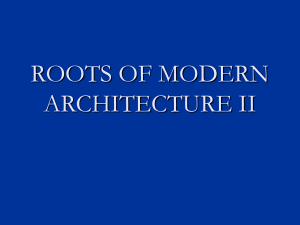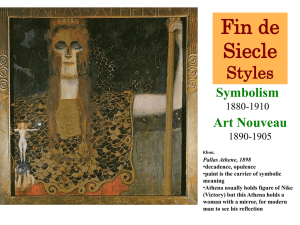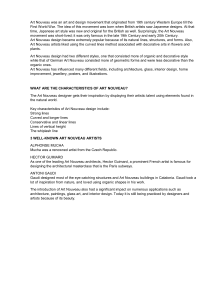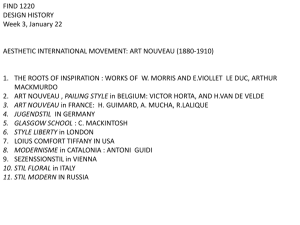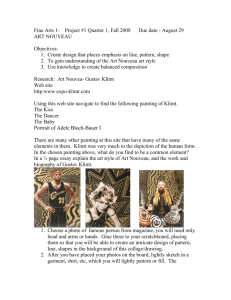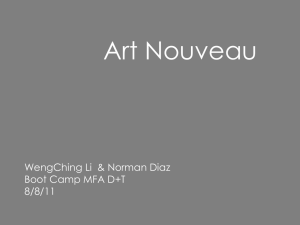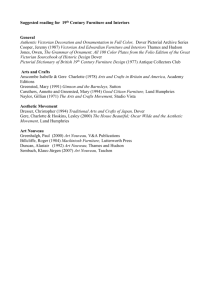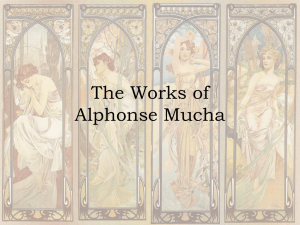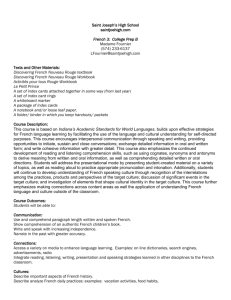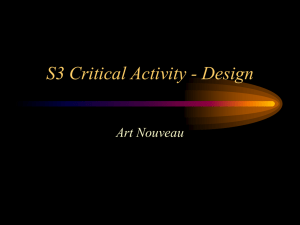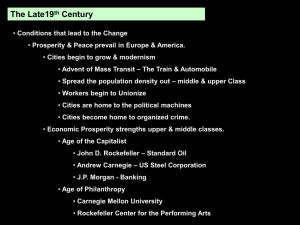art nouveau powerpoint
advertisement
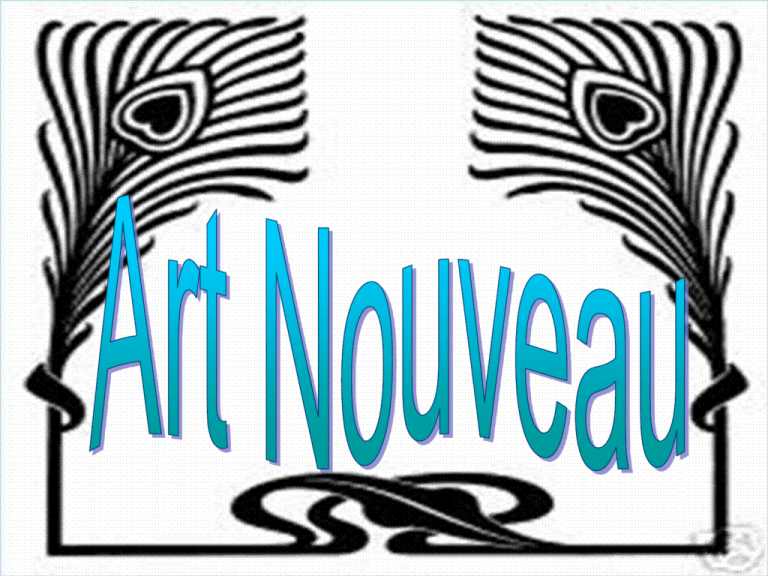
"An international style of decoration and architecture which developed in the 1880s and 1890s which lasted until the first world war. The name derives from the Maison de l'Art Nouveau, an interior design gallery opened in Paris in 1896, but in fact the movement had different names throughout Europe. Germany it wasby known as 'Jugendstil', from theMackintosh, magazine Diejugend "In Britain the style In was exemplified the architecture of Rennie Aubrey (Youth) published fromimages 1896; infor Italy 'Stile Liberty'literature (after the that London store, Liberty Style) or Beardsley illustrated contemporary showcased the curvilinear 'Floreale'; in Spaindespite 'Modernista', in Guimard's Austria 'Sezessionstil' and,and paradoxically, France the the style. "In France, Hector famous glass iron Metro in designs, English termwas 'Modern Style' was often emphasizing the English origins of the movement best expressed in theused, applied arts, especially the glassware andmovement. jewelry "In design Art Nouveau was characterized by flat, decorative patterns; intertwined organic of Rene Lalique (1860-1945) and Emile Galle (1846-1904). forms such as stems or flowers with writhing plant forms, curvilinear depiction of leaves and flowers, oftenthe in the form vines, sinuous linesthe and curvesdes although In Belgium, style wasofpromoted through Societe Vingtsright-angled (Les Vingt)forms are also typical, especially as the style was practiced in Scotland in Austria. established in 1884, including architects Horta and Van deand Velde in its members. Alphonse Muchahandcrafting (Czechoslovakian, 1860-1939), postersthe in use the of style It emphasized as opposed to machinedesigned manufacturing; newafter moving toand France. materials; the rejection of earlier styles. The style pervaded a range of art forms from architecture interior design, furniture to printmaking, illustration, glass Gaudi designinpottery, In Spain theand style was concentrated in the eccentric hands of Antonio jewelry textiles, wrought iron works and graphic design typography. 2-dimensional Art Barcelona. Nouveau pieces were painted, drawn, and quite popular in printed material like advertising, In Vienna, architects like Wagner and artists such Gustav Klimt posters, labels, magazines and the and like. Hoffmann, This was a sharp contrast to as theKlimt traditional separation of art into the distinct categories ofto fine art (painting and through sculpture) and applied artsmagazine (ceramics, (Austrian, 1862-1918), gathered promote the style the Secessionist furniture, and other practical objects). Ver Sacrum.. In America architects like Sullivan and Wright European ideas but “The defining characteristic of Art Nouveau – thewere factorinfluenced that made by it into an intellectually and conceived Art Nouveau in different terms, whilst like Louis Comfort based Tiffany socially cohesive force – was modernity. It was the designers first deliberate, internationally enthusiastically embraced the movement his stainedtoglass works. attempt to transform visual culture through aincommitment the idea of the modern.” – to fit with a world that was becoming increasingly new and changed in every way possible. (The Essence of Art Nouveau, Paul Greenhalgh) Art nouveau in Britain evolved out of the already established arts and crafts movement. Founded in 1861 by English designer William Morris, the arts and crafts movement emphasized the importance of handcrafted work. Morris's devotion to handmade articles was a reaction against shoddy machine-made products that were flooding the English marketplace as the industrial revolution expanded. The arts and crafts movement also promoted a totally designed environment in which everything from wallpaper to silverware is made according to a unified design. British art nouveau designers of the 1890s shared Morris's dedication to hand-crafted work and integrated designs. To these principles they added new forms and materials, establishing the aesthetic of the art nouveau style. In the graphic arts, Aubrey Beardsley drew illustrations for periodicals such as The Yellow Book (1894-1895), and for an edition of the play Salomé (1894) by Irish-born writer Oscar Wilde. Beardsley's vigorous use of line and distinctive double-curves known as whiplash lines have become equated with British art nouveau in the popular imagination. From http://home.arcor.de/oscar.wilde/lifetime/art_nouveau.htm Aubrey Beardsley, 1872-98 Illustrations for Oscar Wilde’s Salome, 1892 •Perverse eroticism •Decadence •Drips of blood from head turn into curving plant forms Gustav Klimt:Water Serpents The Tree of Life, Stoclet Frieze Gustav Klimt: Hygieia Alphonse Mucha was born in 1860 in Ivancice, Moravia, which is near the city of Brno in the modern Czech Republic. Like every aspiring artist of the day, Mucha ended up in Paris in 1887. His way was based on a strong composition, sensuous curves derived from nature, refined decorative elements and natural colors. The Art Nouveau precepts were used, too, but never at the expense of his vision. Bernhardt signed him to a six year contract to design her posters and sets and costumes for her plays. Mucha was an overnight success at the age of 34, after seven years of hard work in Paris. by Jim Vadeboncoeur, Jr. http://www.bpib.com/illustrat/mucha.htm Art Nouveau furniture by the cabinet-maker Louis Majorelle, one of the most influential desig ners of the Art Nouveau movement Staircase of Hotel Tassel; by Victor Horta, Bruxelles; 1892-93 Metro Station, Paris Hector Germain Guimard's subway entrances for the Paris Metro (early 1900s) are his most famous creations. Using wrought iron, bronze, and glass, Guimard composed his structures using the curves characteristic of the Art Nouveau style Casa Mila was built in Barcelon, Spain between 1905-1910. Style is Art Nouveau in urban context.Building type is multifamily housing. This work of Antonio Gaudi is characterize with expressionistic, fantastic, organic forms in undulating facade and roof line; light court. Sagrada Familia The Greatest work of Antonio Gaudi http://gaudi.hit.bg/ It was built in Barcelona, Spain between 1882-1926. Style is expressionist in urban context. Building type is church and it is called "Church of the Holy Family". This work Gaudi could not complete before his death. Victor Horta's House The elaborate wrought-iron and glass-window facade, center, of this house in Brussels, designed and built in 1898 by Belgian architect Baron Victor Horta, displays his preference for the European style of art known as art nouveau. The architect's decorative "whiplash lines," inspired by the look of natural vegetation, flow throughout the house's exterior design. Noted for his emphasis on ornamentation, Horta created buildings with elaborate exteriors and carefully planned interiors. Emile Gale Vases Tiffany Lamp Emile Galle Glass Lamp ’The Tree of Life stained glass by Louis Comfort Tiffany (18481933) Art Nouveau Jewelry
